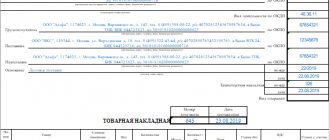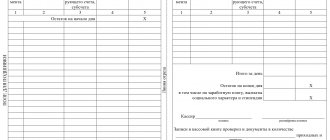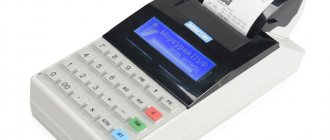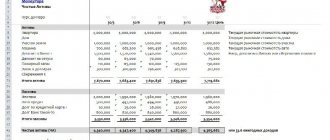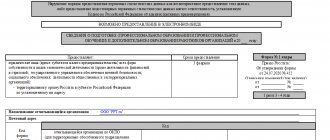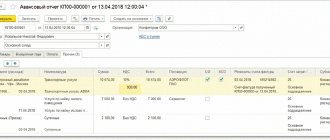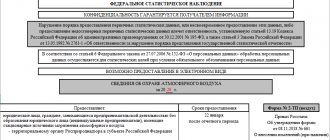The procedure for conducting cash transactions and working with cash is established by document No. 3210-u dated 11/03/14 of the Central Bank of the Russian Federation. Until this year, an error made when maintaining a cash book became a serious problem for the organization. It was forbidden to make corrections. Violation of the rule resulted in a fine. Currently, the ban has been lifted, but the question of how to correct an error in the cash book in order to avoid questions during verification is relevant.
Is it possible to make corrections to the cash book ?
How to correct an error in the cash book
The question of the possibility of edits has been resolved, now let’s reproduce the algorithm for making corrections:
Step 1.
You need to cross out the erroneously entered data.
Step 2.
Next to the crossed out erroneous data, enter the correct data. It is very important that they are readable and legible.
Step 3.
We indicate the date the corrections were made.
Step 4.
The signature of the person by whom the corrections were made is affixed, with a transcript.
Corrections must be made by the same employee who originally compiled the document. Since the cash book is maintained by a cashier or accountant (this responsibility is assigned to them by order), it is they who will have to make corrections when errors are detected.
IMPORTANT! If an error is discovered that was made several days ago, and it affects the cash balances, the data of which is transferred to subsequent sheets of the cash book, then all sheets that require such corrections are subject to correction.
The material “Cash Discipline and Responsibility for Violating It” will help you check whether you are making mistakes in cash discipline.
Are changes allowed?
As of June 1, 2014, the generally binding rules governing the procedure for performing and recording cash transactions by business entities have significantly changed.
One of these innovations is the ability to correct entries in the cash book. A similar option is provided by Directive of the Central Bank of the Russian Federation No. 3210-U dated March 11, 2014.
Thus, according to paragraph 4.7 of this regulatory act, it is allowed to make amendments to documents drawn up on paper, but not related to cash documents.
However, such adjustments must be made in strict accordance with established requirements.
The above-mentioned Directive of the Central Bank of the Russian Federation No. 3210-U classifies as cash documents only an incoming cash order (abbreviated as PKO) and an outgoing cash order (abbreviated as RKO).
This conclusion can be drawn from the first paragraph of clause 4.1 of this regulatory act, the provisions of which clearly establish what documents should be used to document cash transactions in the organization.
Of course, cash documents are not subject to any adjustments - this requirement is regulated by the content of clause 4.7, as mentioned earlier.
If errors are made in the documentation, such papers should simply be rejected and drawn up again.
Can I make mistakes on paperwork?
Guided by the content of Directive of the Central Bank of the Russian Federation No. 3210-U, it can be argued that the cash book is mentioned in this regulatory act, but does not refer to cash documents.
A cash book is a consolidated register that takes into account information about cash transactions according to cash register and cash register accounts.
Accordingly, a cash book on paper may be subject to adjustments (corrections), if the changes made are made according to generally accepted rules - accompanied by the date of correction, as well as indicating the full name and signature of the subject who issued the corrected document.
In electronic format
The cash book, which is maintained (filled out) in electronic format, is not subject to correction after it is signed.
This norm is established by the third paragraph of paragraph 4.7 of the above-mentioned Directive of the Central Bank of the Russian Federation No. 3210-U.
If inaccuracies are allowed, a new document that no longer contains errors should be created and signed.
How are adjustments made?
How to correctly correct a paper cash book if inaccuracies/errors are found in it?
The procedure for making such edits is carried out according to the following algorithm:
- Erroneous, incorrect information (text, numbers) is crossed out with one line. The corrected data must be visible after such a crossing out.
- In the immediate vicinity of the erroneous (crossed out) data, new, correct information is entered. An important requirement is the legibility of new information and its accessibility for reading.
- Next to the correction performed, the date of change (correction) of the data is indicated.
- The subject who directly carried out this correction signs the correction made. His signature is properly deciphered here.
If an error or inaccuracy is revealed in the book, made some time ago, but affecting the cash balance, and information about such balances is transferred to subsequent pages of this register, then proper adjustment of all its sheets that need correction will be required.
Whose signature is the amendments made?
If errors/inaccuracies are identified in the organization’s cash book, its proper adjustment is carried out by the very entity – the organization’s employee – who originally compiled (filled out) this document.
The book, as you know, is filled out by a cashier or, alternatively, an accountant.
This responsibility is assigned to the cashier/accountant by the relevant administrative act - a special order from management.
Therefore, it is the cashier/accountant who must make the necessary adjustments to this cash transaction register if errors are identified that need to be corrected.
It turns out that the cashier/accountant certifies the corrected inaccuracies with their signatures. The chief accountant or manager controls the maintenance of this register.
Corrections in the cash book: sample
Now let's move on from theory to practice, and, following the instructions we previously presented, we will make changes to the cash book.
Let’s imagine that in the cash book the corresponding account was incorrectly indicated for the amount issued for the account for the consumables. This is what the cash book sheet looked like before the correction:
| Document Number | From whom it was received or to whom it was issued | Corresponding account number, subaccount | Income, rub. cop. | Expense, rub. cop. |
| Balance at the beginning of the day | 10 000 | X | ||
| Orlov K. A. | 3 000 | |||
| Total for the day: | 3 000 | |||
| Finally the rest of the day: | 7 000 | X | ||
Cashier Kulikova D.I.
I checked the entries in the cash book and received documents in the amount of ____-____ receipts and __one__ expenses.
Accountant Tarasova N. G.
And this is what the cash book sheet will look like after correction:
| Document Number | From whom it was received or to whom it was issued | Corresponding account number, subaccount | Income, rub. cop. | Expense, rub. cop. |
| Balance at the beginning of the day | 10 000 | X | ||
| Orlov K. A. | 51 71 | 3 000 | ||
| Total for the day: | 3 000 | |||
| Finally the rest of the day: | 7 000 | X | ||
Cashier Kulikova D.I.
I checked the entries in the cash book and received documents in the amount of ____-____ receipts and __one__ expenses.
Accountant Tarasova N. G.
Corrected believe Cashier Kulikova D.I. 08/23/19
Now you know exactly how to correct the error made in the cash book correctly.
Book elements
The main element of the document is the loose leaf and the cashier’s report. They are absolutely identical, but the loose leaf is always in the book, while the cashier's report is carefully torn out of it and attached to orders received and issued throughout the day. The sheet and report for the same date have the same page numbering.
When filling out the book by hand, the data is entered onto the page of the book and into the report.
How to fill out RKO correctly
Important! Today, in cash settlement services, the recipient does not necessarily have to fill out the amount received by hand. It can also be printed on a computer (instructions of the Bank of Russia No. 3210-U dated March 11, 2014).
RKO (expenditure cash order) can be issued either by hand or using special technical means. When filling out the cash register by hand, you can use any color of ink; there are no restrictions in this case. In the “Base” line, the content of the business transaction is indicated, for example, like this: “Reimbursement of overexpenditure according to the advance report dated August 31, 2018 No. 123.” The “Appendix” line should contain a list of attached primary documents (invoices, applications, etc.), indicating their numbers and dates of preparation.
RKO numbering can be done at will, as is convenient for the organization. As a rule, numbering is used in ascending order or using a combination of letters and numbers. Numbering can be continuous or non- continuous. The procedure for maintaining cash documents does not oblige companies to maintain their continuous numbering. There is no liability for violation of order numbering. However, if omissions or duplicate numbers are found, the regulatory authorities may conclude that there may have been unaccounted funds in the cash register. And this in turn will lead to a more thorough check (
Highlights ↑
Previously, all business entities were required to maintain a cash book. The new Directive of the Central Bank of the Russian Federation No. 3211-U allowed individual entrepreneurs not to maintain cash books.
Individual entrepreneurs and small businesses are only required to generate payroll and payroll statements when paying wages and other remunerations in cash to individuals.
For legal entities, maintaining a cash book is still mandatory. At the same time, there is no prohibition on the use of cash documents by individual entrepreneurs.
Legislative amendments mean that inspection authorities do not have the right to check the availability of this documentation and punish for its absence. If it is convenient for an individual entrepreneur to use a cash book, then he can use it to keep cash records.
According to the new Directive, the procedure for maintaining cash documentation now differs between regular and simplified. Individual entrepreneurs and small businesses should maintain documentation in a simple manner.
As for legal entities, except for banking organizations, they are required to apply the usual cash accounting procedure. The forms of standard cash documents have not changed since the entry into force of the new Central Bank Decree.
What it is
When analyzing the term “cash book”, it is worth paying attention to such concepts as cash register and cash register. These definitions are often confused with each other. This makes it difficult to understand what exactly a cash book is.
A cash register or cash register is a device required when accepting cash. That is, when something is sold for cash, an economic entity is required to use a cash register.
In some cases, it is possible to use strict reporting forms instead of cash receipts. The cash register is the totality of absolutely all cash transactions of an entrepreneur.
The cash register displays cash income and expenses. All cash revenue received, including through a cash register or cash register, must be reflected at the cash desk.
Maintaining a cash book is in no way connected with the calculation of tax payments. Even in the absence of cash transactions and cash registers, it is still necessary to maintain a cash register.
For example, expenses do not affect the calculation of tax when applying the simplified tax system or UTII.
A cash book is a document that reflects all income and expense transactions with an entrepreneur's cash.
This document contains information about all deposits from clients, suppliers, funds issued to creditors, contractors, etc.
The Goskomstat resolution approves a unified form for the cash book, which is called KO-4. The book is kept on an accrual basis from the beginning of the year.
At the end of the calendar year, a new cash book is opened. If the book ends before the deadline, it is allowed to start another one and continue keeping records in chronological order.
For a sample of manually filling out a cash book, see the article: How to properly maintain a cash book. Read the procedure for maintaining a cash book in electronic form here.
As a rule, a ready-made book form, produced by printing, is used. It already has the required columns and columns lined up. It is also not prohibited to maintain a cash book in electronic format.
Recommendations for filling
The standard appearance of the cash book makes it easier to fill out. But you still need to comply with some requirements regarding the procedure for drawing up this document.
The main recommendations for filling out are as follows:
| Book title page | Must contain full details of the legal entity or individual entrepreneur. The time interval over which records will be kept is also indicated. |
| One book can be used for no longer than one year | It is strictly forbidden to keep one cash book for several years. |
| All pages of the document must be numbered and bound | The number of sheets must be indicated on the back of the book. |
Maintaining a cash book includes strict execution of this procedure based on six documents:
| Books of accounting of issued/received funds | Which is required to account for cash flow during the day |
| Incoming and outgoing cash orders | How is cash received and issued from the cash register formalized? |
| Cash book | Necessary for collecting information about cash transactions |
| Payroll | Used to record paid wages |
| Payroll | Necessary for recording working hours, deductions and salary payments |
In light of the new adjustments to the procedure for maintaining cash accounting, the following nuances that have arisen can be noted:
| Cash documentation can be maintained in electronic format | Documents are confirmed by electronic signature |
| Second sheet of the cash book (cashier's report) | No need to fill out |
| A general cash receipt order can be created | Both on the basis of the KKM control tape for the day, and on the basis of BSO |
| The recipient no longer has to enter the amount | Cash received in the cash settlement order |
| When issuing cash to an employee, report | It is necessary to draw up an application in any form. This is drawn up indicating the amount, period of use of the issued funds, date and signature of the manager |
| Statement of payment of wages | As before, it assumes that there is a “deposited” entry opposite the employee’s last name. Maintaining a register of deposited funds has become optional |
Normative base
The procedure for conducting cash transactions in the Russian Federation was approved by the Board of Directors of the Central Bank of the Russian Federation in 1993. In accordance with it, the organization's cash book must be numbered, laced and certified with a seal.
When filling out the cash book, each entry in it must be certified by the signatures of the chief accountant and the manager. According to the approved Procedure, the cash book is the main document confirming the receipt and expenditure of cash.
It consists of a list of incoming and outgoing orders for the cash register, having a prescribed form. The book also contains information about the cash balance at the beginning and end of the day.
Warrants are filed with the cashier's report in form KO-3. The totality of the cash book and cashier's reports are the main accounting documents when maintaining an account 50.
Resolution of the State Statistics Committee of the Russian Federation No. 88 dated August 18, 1998 approved special forms of primary documentation.
Here are also examples of forms PKO 0310001, RKO 0310002 and cash book 0310004. The same Resolution determines the maintenance of a book in a single copy.
If a company has structural divisions operating on a separate balance sheet, each one maintains a separate book. Copies of the cash books are sent to the main office.
From June 1, 2014, in accordance with Directive of the Central Bank of the Russian Federation No. 3210-U, the procedure for conducting cash transactions has been changed. The form of the book has been preserved. The changes were reflected in the optionality of maintaining this document for individual entrepreneurs.
Procedure for filling out RKO
The director’s signature on the order is not required if his signature is in the appendices to the RKO. If the company does not have an accountant, then the manager’s signature will be required in any case, even if he has already signed the attachments to the order.
When working with RKO, an organization should have the following procedure:
- The cashier must check the presence of the necessary signatures, the correspondence of the amounts recorded in figures and words, and whether all the documents specified in the cash register are present. In addition, the coincidence of the full name on the document with the data of the presented ID of the recipient is checked.
- You should prepare the required amount of money for the recipient, and also obtain his signature in the cash register.
- The cashier must count the money in front of the recipient so that the recipient can observe his actions. After this, the money is issued to the recipient
- After this, the money is counted by the recipient in the presence of a cashier. If this is not done, then it will no longer be possible to file a claim.
- The last step is the signing of the cash register by the cashier.
Results
A cash book is a mandatory document when working with cash, be it revenue or other payments. Its form and procedure are strictly regulated, and violations when working with it may result in liability. Therefore, it is very important to maintain this cash register accurately and without errors.
Acceptance of cash proceeds, as a rule, obliges the recipient to have a cash register that issues a document confirming the acceptance of the corresponding amount. Currently, a new type of cash register has become mandatory - online cash registers. They generate not only cash receipts, but also BSO. Accordingly, the requirements for new cash registers and the documents issued by them have changed.
There are no changes in 2019–2020 regarding the documents generated by the operating cash desk. Just as there are no changes in the authority that checks the state of cash discipline (i.e. compliance with the rules for working with cash), it remains the Federal Tax Service Inspectorate. Despite the limited period for bringing to justice for violations when working with a cash register, the detection of such violations is fraught with consequences in the form of an on-site tax audit.
Administrative liability itself has been significantly increased since 2021: the amount of fines has increased, the types of liability for non-use of cash registers have been expanded, and in connection with the start of work with a new type of cash register equipment, new grounds for prosecution have been introduced.
What mistakes are most often made in RKO
If we look at the practice of auditing cash payments, we can conclude that there are quite a lot of violations in this area, including in the preparation of cash documents. The most common violations are the following:
- lines are filled in carelessly when filling out manually, or lines are shifted when filling out a document on a computer;
- RKOs are not numbered;
- there are no corresponding accounts (sub-accounts) in RKO;
- the line “Attachment” does not indicate all the details of the attached documents;
- VAT allocated incorrectly;
- The full names of the persons signing the RKO are entered illegibly, some signatures are missing;
- blots, corrections or erasures were made in the RKO.
Error in cash receipt order: how to fix?
Important! Corrections are not allowed in cash documents. If a mistake is made in the RKO, it should be rewritten.
There should be no corrections in cash documents. The same requirement applies to cash settlement services (Bank of Russia Directive No. 3210-U, clause 4.7).
If an error is discovered, it is no longer possible to correct the RKO. The only option is to compile it again with the correct data.
If the tax authorities discover that there are corrections in a cash document, then this document may be considered missing, which will lead to the company being accused of storing unaccounted revenue. For example, for exceeding the established limit at the cash register. And for this the fine can be up to 50,000 rubles (15.1 Code of Administrative Offenses of the Russian Federation).
When drawing up a new cash register, instead of an incorrect one, the previous order should be crossed out and attached to the cash book. At the same time, it should be indicated in the PKO and RKO registration log that incorrect orders have been cancelled. This entry is made in the notes. In the cash book, you should also cross out the incorrect entry and write down the correct amounts instead of the incorrectly recorded amounts. All corrections in the book must be certified by the signatures of the cashier and the chief accountant.
If the cashier made a mistake in any figures when filling out the cash register, then an explanatory note should be taken from him. In the explanatory note, he must indicate why he made mistakes in the numbering. In this case, disputes with regulatory authorities may be avoided (
FAQ
The payment method was confused: instead of “cash” they indicated “non-cash”. What to do?
In FFD 1.05, correct the error with a refund check, in FDF 1.1 - with a correction check. Since 1.1 is not yet widely used, we’ll talk about 1.05. To correct the error, issue a check with the attribute “Return of receipt” with the payment type “Cash”, and then generate a correct check with the attribute “Receipt” and the payment method “Non-cash”. After this, notify the Federal Tax Service about the correction.
The cashier does not allow you to enter additional check details. What should I do?
The additional check detail (1192) has the lowest requirement, that is, it may not be on the check. If it is impossible to indicate the details for technical reasons, this will not be considered a violation (Appendix No. 2 to the order of the Federal Tax Service of Russia dated March 21, 2017 No. MMV-7-20 / [email protected]
When returning, instead of the “Return of receipt” attribute, the cashier indicated “Return of expense”. What to do?
- Generate a check for “Expense” with the same data as the erroneous check, and indicate the FPD of the first check. And then create the correct check.
Responsibility for incorrectly completed cash register
There is no penalty for filling out the RKO or PKO incorrectly. However, if the document is filled out with errors, the inspection authorities may consider it missing. For example, if there is no decoding of the surname in the RKO, this means that the document was drawn up with violations. The RKO must be signed in such a way that the signature can be used to identify the signatories, that is, those persons who are responsible for processing this transaction.
Important! If there is no transcript of the signature, then the inspection authorities can equate the warrant with missing documents, and this can lead to a fine of 10 thousand rubles (120 Tax Code of the Russian Federation).
This fine may be imposed on the basis that the company’s primary documents are not properly prepared. However, the imposition of such a fine is also unlawful, since it is provided for the fact that documents are missing, and not for the fact that they are executed incorrectly. In this case, the courts may side with the organization.
What, then, can lead to incorrect drafting of RKO? A document executed in violation may cause them to lose their evidentiary value. For example, if in court it will be necessary to prove the fact of issuing cash to a certain person who declares that he did not receive any money.
Amount of fines ↑
The Tax Service checks the correctness of cash discipline by organizations. However, there are no specific deadlines or frequency of inspections.
During the year, the number of inspections is determined exclusively by regulatory authorities. Violation of keeping score 50 provides for punishment under the Administrative Code of the Russian Federation (Article 15, paragraph 1).
The fine for the organization reaches fifty thousand rubles. The statute of limitations for this offense is two months. Corrections in the cash book must be carried out in accordance with established requirements.
Find out whether an individual entrepreneur should keep a cash book from the article: individual entrepreneur cash book.
What is a cash book?
Sample of filling out a cash receipt order.
If the tax authority discovers non-compliance with the established procedure, the company will be fined. But you need to take into account that a fine can only be imposed if an error is discovered that was committed no earlier than two months at the time of the inspection.
Changes in legislation have significantly simplified the procedure for conducting transactions on account 50. The ability to maintain an electronic book has also become a significant advantage. Thus, accounting becomes more perfect.
But in any case, whether the cash book is kept in paper or electronic form, it is better to avoid mistakes. Although these can be corrected from now on, they take up a lot of working time.
Previous article: How to properly maintain a cash book Next article: How to properly sew a cash book
Answers to common questions
Question: Is it possible to fill out part of the RKO by hand, and part on the computer?
Answer: The legislation does not establish a ban on filling out cash registers using a combined method. If it is convenient for the company, then part of the document can be filled out on the computer, and the rest by hand.
Question: In RKO, the corresponding account is indicated incorrectly. How to fix this if the employee signing this document has already quit?
Answer: No changes can be made to the RKO. In this regard, the employee who compiled the RKO must be required to provide an explanatory note, as well as draw up an accounting certificate that will explain the reasons for the discrepancy.
Rate the quality of the article. We want to become better for you: If you have not found the answer to your question, then you can get an answer to your question by calling the numbers ⇓ Free legal advice Moscow, Moscow region call
One-click call St. Petersburg, Leningrad region call: +7 (812) 317-60-16
Call in one click From other regions of the Russian Federation, call
One-click call
> Test task
What you need to know about working with CCP
The requirements for the CCP used in 2019–2020 are determined by the updated law No. 54-FZ.
From 02/01/2017, only new-style cash registers (online cash registers) began to be registered with the Federal Tax Service. From July 1, 2019, this type of cash register became mandatory for use by almost all business entities.
Online cash registers are fundamentally different from previously used cash registers with a fiscal drive. Accordingly, the requirements for them are completely different.
For general requirements that online cash registers must meet, read the article “Where and at what price can you buy an online cash register?”
The problems that arise during their work also became different.
You will find answers to many questions related to the use of online cash registers in our section “Online cash registers KKT KKM”.
At what stage of document flow formation should a primary accounting document be drawn up?
1) on the day of the economic event;
2) immediately, no later than the working day following the day of the economic event;
3) immediately at the time of the economic event, and in the absence of such an opportunity, immediately after its completion
Answer: 3 - immediately at the time of the economic event, and in the absence of such an opportunity, immediately after its completion.
According to Art. 9. Federal Law on “Accounting” - the primary accounting document must be drawn up when a fact of economic life is committed, and if this is not possible, immediately after its completion. The person responsible for registration of the fact of economic life ensures the timely transfer of primary accounting documents for registration of the data contained in them in the accounting registers, as well as the reliability of this data. The person entrusted with maintaining accounting records and the person with whom an agreement has been concluded for the provision of accounting services are not responsible for the compliance of primary accounting documents compiled by other persons with accomplished facts of economic life.
What documents can be corrected?
When making changes to a document, the period of its preparation does not matter. Simply put, you can correct both a document drawn up on the current day and on previous days. The exception is a document on which information has already been sent to the tax authority or its existence has already affected the financial result of the institution and is taken into account in the final financial statements.
At the same time, there will be significant differences between making changes to a document drawn up on paper and a document drawn up and approved via an electronic digital signature.
Are corrections allowed in cash and bank documents?
1) corrections are allowed in cash documents, but not in bank documents;
2) corrections are allowed in bank documents, but not in cash documents;
3) are not allowed.
Answer: 3 - not allowed.
According to paragraph 16 of the “Order on approval of the regulations on accounting and financial reporting in the Russian Federation”, making corrections to cash and banking documents is not allowed. Corrections can be made to other primary accounting documents only by agreement with the persons who compiled and signed these documents, which must be confirmed by the signatures of the same persons, indicating the date of the corrections.
reporting person valuation of inventories
Thus, in the test work the goals were achieved and the basic concepts were revealed:
accountable persons - employees of the enterprise who have received funds on account for upcoming travel expenses, for payment of office and postal and telegraphic expenses, for expenses associated with the acquisition of material assets (in retail trade, for the purchase of fuels and lubricants and for other economic needs) .
production inventories are a collection of items of labor used in the production process. They participate in the production process once and completely transfer their value to the products produced, work performed or services provided.
Is it possible not to print an electronic document?
Companies have the right to maintain a cash book electronically without printing it. In this case, the enterprise completely switches to electronic document management. The basis for filling out the cash book is any financial transaction performed in the company.
The ability to maintain documentation exclusively in electronic form appears only after the company purchases certain technical equipment. They are the ones who ensure data protection from fraudsters and hackers. By using them, it is ensured that the person in charge cannot in any way make a mistake. Additionally, documentation is protected from loss of information.
All electronic samples of the book must be signed using an electronic signature, which must meet the conditions of Federal Law No. 63. The electronic version is slightly different from the paper document in appearance, but it contains the same rows and columns.
If an entrepreneur decides to switch completely to the electronic version of the book, then he must prepare for serious expenses associated with the purchase of expensive equipment. The selected cashier must be able to operate this equipment.
